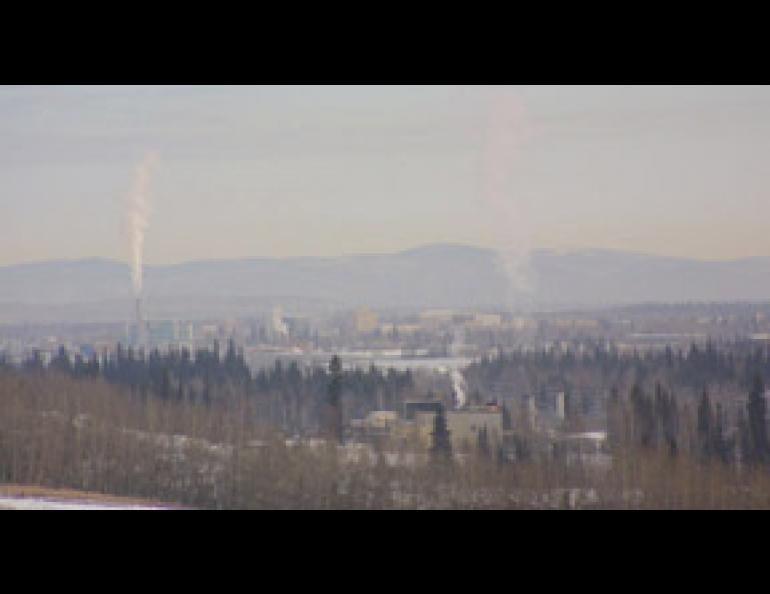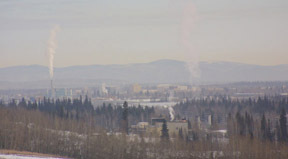
Alaska's Urban Air Quality Has Come a Long Way
The 1970s and 1980s were the bad old days of Alaska air quality.
In 1972, Fairbanks exceeded federal air standards for carbon monoxide pollution on 168 days, almost half the year. In the early 1980s, Anchorage went over the limit for as many as 52 days per year.
Today, both Fairbanks and Anchorage have cleaned up their acts. Anchorage exceeded the standard just once in the last four years; Fairbanks has had a clean record for the last two. In a new report on a cold-weather vehicle test done in Fairbanks, researchers describe how Alaskans have improved the quality of urban air and answer the lingering question of whether it's better to leave a car idling in cold weather or shut it off.
Alaska's two largest cities are vulnerable to bad air because they are both located in natural bowls that hold in pollution and both cities experience temperature inversions that make the bowls smaller by trapping cold air under warmer air. When inversions are strong and people drive with cold engines, Anchorage and Fairbanks can violate air-quality standards of 9 parts per million of carbon monoxide set by the Environmental Protection Agency. Carbon monoxide, abbreviated CO, is a colorless, odorless gas that limits a person's ability to process oxygen.
Frank Di Genova is the physics and environmental science vehicle lab director of Sierra Research in Sacramento, California. At the request of the Alaska Department of Environmental Conservation, Di Genova and coworkers tested 35 vehicles in Fairbanks during the winter of 2000-2001. The research group tested the vehicles under a variety of conditions, and they sampled all the gases sputtering out the tailpipes for one week.
Their results:
• Trucks spewed 33 percent more CO than cars.
• Vehicles with more than 100,000 miles emitted 140 percent more CO than vehicles with less than 50,000 miles.
• When temperatures are between 20 degrees Fahrenheit and minus 20 F, vehicles plugged in two hours prior to starting emitted 59 percent less CO during the start and 10-minute warmup idle than did cold-started vehicles.
• After plugging in for two hours, the optimum warm-up time before driving a vehicle was about 10 minutes. Warming up vehicles for longer or shorter than 10 minutes resulted in increased CO emissions.
If Fairbanks and Anchorage stay clean, the cities may be able to step down from the EPA's list of the six worst CO violators. Other cities listed as "serious" offenders as of January 15, 2002 are Las Vegas, Los Angeles, Phoenix, and Spokane.
The air of urban Alaska has improved for technical and sociological reasons, according to Paul Rossow, an air-quality specialist with the Fairbanks North Star Borough. Emissions control programs have taken some of the worst offenders off the road in both cities. In November through March, vehicles in Anchorage use oxygenated fuel, which leans out a vehicle's fuel mixture. Fairbanks has not had strong inversion conditions in the past few years, and people in both cities are buying new cars and pulling older cars and trucks off the road. TV and radio ads encouraging urban Alaskans to plug in when it's colder than 20 degrees may also be helping, along with free borough bus rides.
"The combination of all these factors has finally caught up," Rossow said. "It seems a lot less likely for us to have exceedances these days, but if everybody stopped plugging in, we might have a real problem."
When northerners plug in their cars, they activate several heating devices, the most common being oil pan warming pads, battery blankets, and frost-plug heating elements. A recent study showed that plugging in for two hours adds about 14 cents to an electric bill.
Sierra's study also touched on the old-time Alaska debate of leaving a car idling in cold weather versus shutting it off. Di Genova and his staff measured the exhaust of cars left idling for up to one hour, then compared the idling cars' emissions with cars shut off for the same amounts of time and then cold-started.
"We didn't see any statistically significant difference in CO emissions," he said.





